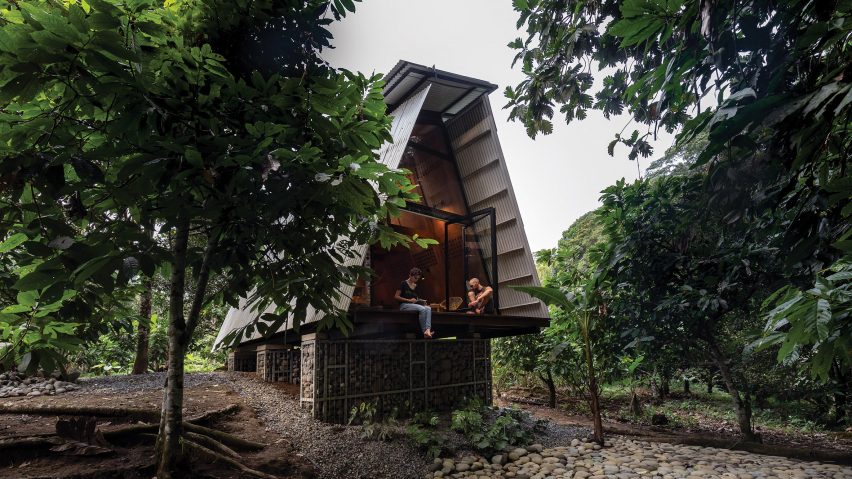Tetra Pak cladding shelters the prefabricated plywood structure of the Huaira cabin, which architects Diana Salvador and Javier Mera have built for themselves beside a river in Puerto Quito, Ecuador.
Hidden amongst dense vegetation on an orange, banana and cocoa farm, the rural cabin was designed by Salvador and Mera as a quiet retreat that would allow them to reconnect with nature.
Its structure and form are deliberately simple, recyclable and adaptable, ensuring it has a low environmental impact and retains focus on its natural setting.
"The mission, a specific need, a refuge outside the city, with contact with the essence of nature," Salvador told Dezeen.
"The purpose was to generate a peaceful place that offers continuous experimentation and stimulates a connection with the natural environment. It sounds a little bit romantic, but it is really sad it has been forgotten, just a few people know how beneficial nature can be."
Huaira measures 40 square metres and has a distinctive pitched form containing two floors of living space. This includes a bathroom, a sitting room and a kitchen, and a small bedroom accessed by an alternating tread stair.
The bathroom is positioned at the front of the dwelling and features a shower encased by a glass box that projects from the cabin's facade, immersing users in nature as they bathe.
The cabin's small size provides ample space for the family to stay there comfortably once a week while ensuring it can also be used as a holiday getaway for tourists on the other days.
"Our life is simple, and that is how the house is solved," added Salvador. "We use it to be at peace and for that purpose, it contains just necessary minimum areas."
The main structure is made from prefabricated plywood, elevated on stone-filled gabions. These gabions protect the house from heavy rain or the flooding of the adjacent river.
It is sealed with glass windows and a roof and cladding made from Tetra Pak in the form of corrugated sheets.
The materials used to build the cabin were all chosen for their low-carbon footprint and to allow the dwelling to be completely recycled or reused at the end of its useful life.
Plywood was used for the main structure in recognition of its sequestered carbon, which the duo hopes will help offset the minimal carbon emissions of the building over its life.
Sequestered carbon is the amount of carbon dioxide that a tree removes from the atmosphere as it grows and subsequently stores as carbon.
In order to limit the carbon consumption of Huaira when in use, Salvador and Mera designed its shell to facilitate natural ventilation – eliminating the need for air conditioning. This includes perforations in the walls that enable cross ventilation.
The roof also features a retractable layer that can be used to cover a skylight and limit the amount of direct sunlight reaching the interiors and in turn help to cool the cabin.
Architecture student David Guambo also recently completed a wooden cabin in rural Ecuador, which is elevated on stilts and used as his own studio.
In Quito, Ecuadorian studio El Sindicato Arquitectura built a 12-square-metre parasitic structure atop an existing building. Despite its small footprint, it has a bathroom, kitchen, bed, storage and space for eating, working and socialising, all within its 12-square-metre footprint.
Photography is by JAG Studio.
Project credits:
Architects: Diana Salvador, Javier Mera
Bioclimatic engineering: Grace Yépez, Nicolas Salmon
Structural engineering: Patricio Cevallos
Furniture: Juan Subía
Project coordinator and constructor: Diana Salvador

